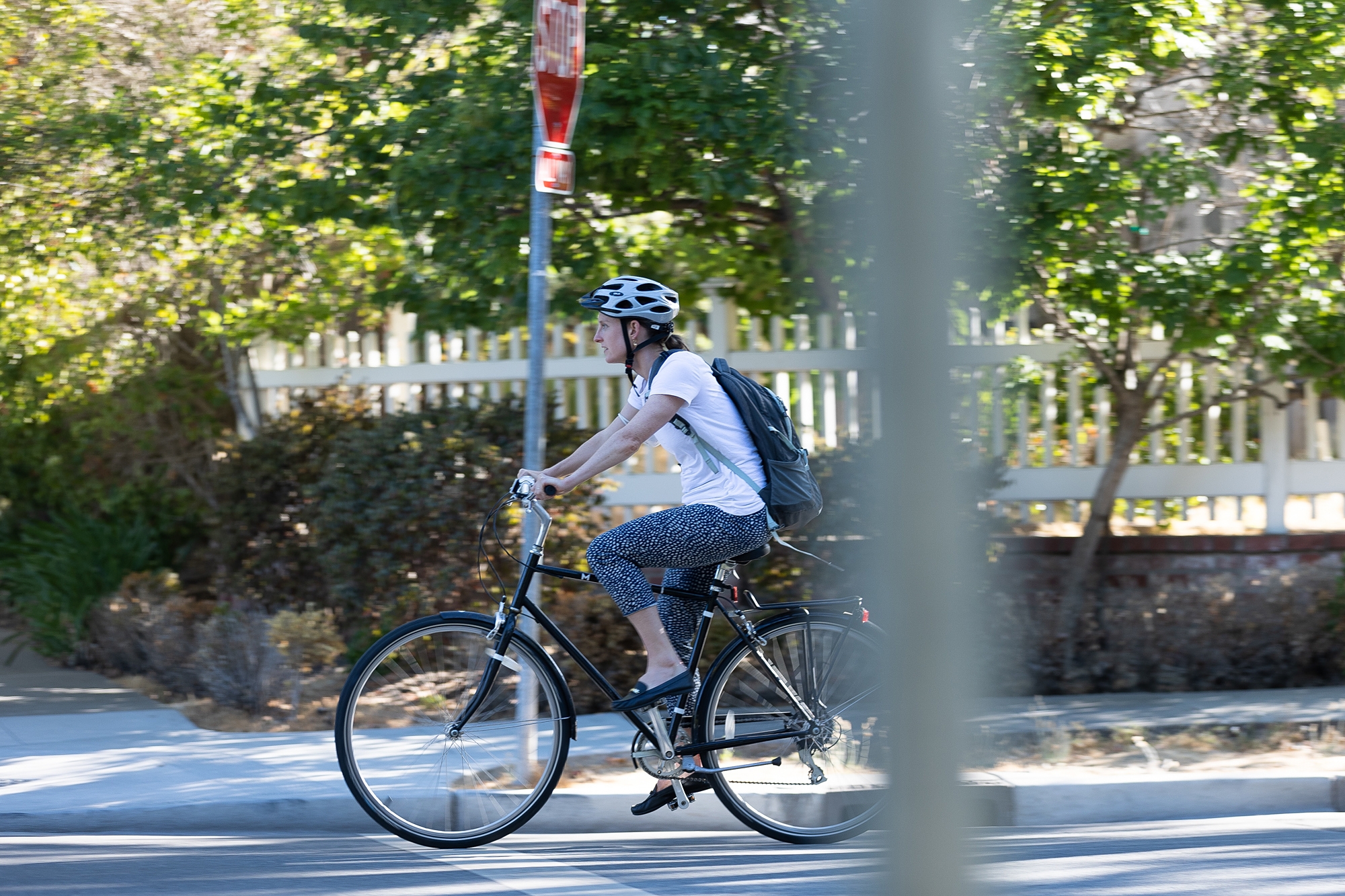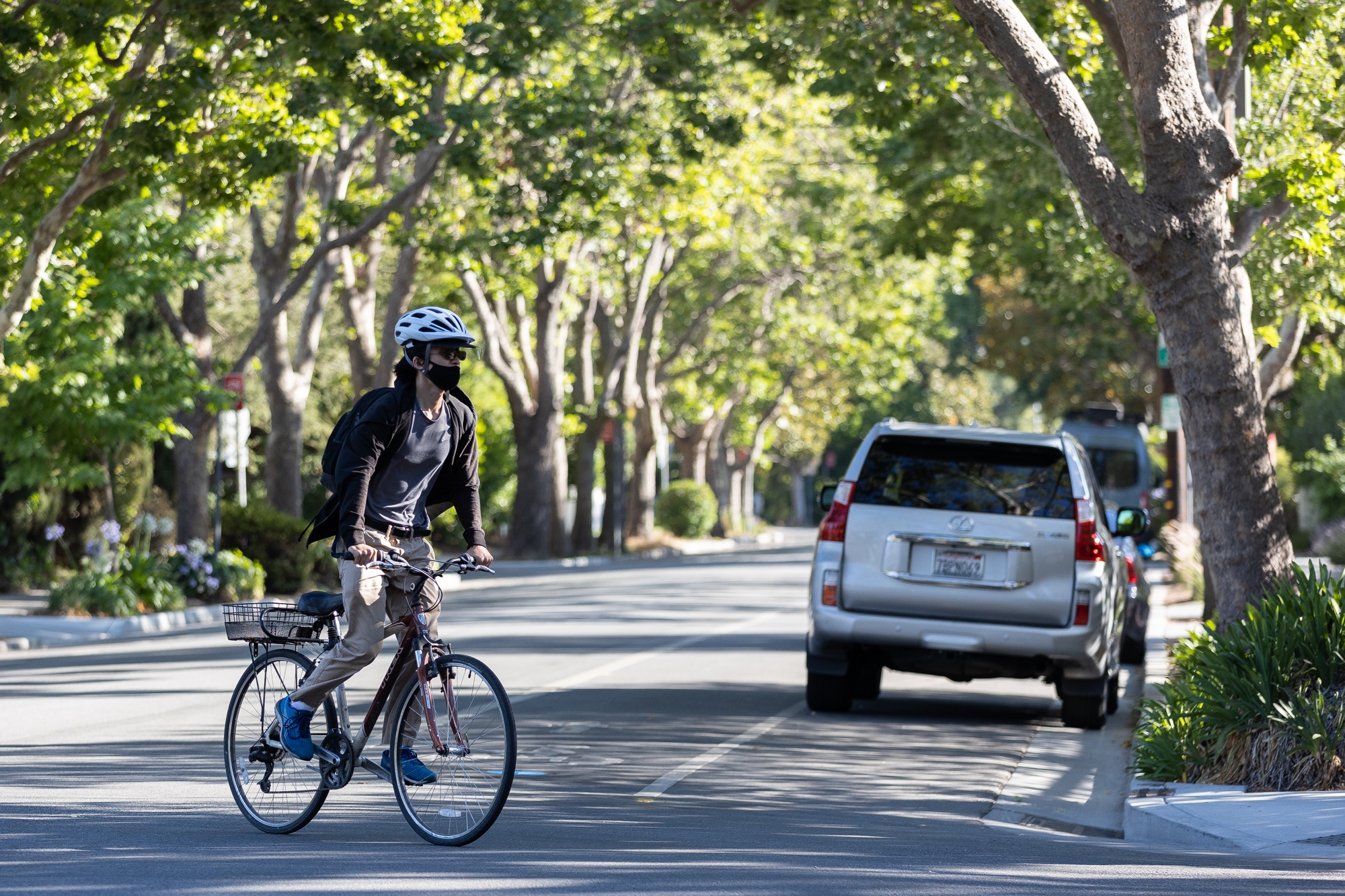Few roads better epitomize the frustrations of Peninsula's bicycle advocates than El Camino Real, a critical north-south connector that offers both the most direct and, arguably, the most perilous route between Redwood City and Mountain View.
Living up to its moniker as "The King's Highway," the original connector between California's network of Spanish missions is today dominated by cars in just about every Peninsula jurisdiction through which it passes, despite years of talk around the region about converting it into a multimodal "grand boulevard."
And even as each city has been making its own bike-safety improvements (Palo Alto, for instance, is now completing construction of a bike bridge over U.S. Highway 101 as well as planning for further bike improvements along East Meadow Drive and on the Charleston-Arastradero corridor), these efforts have largely steered clear of El Camino.
A recent traffic analysis commissioned by city managers from Peninsula cities concluded that the 12.5-mile stretch of El Camino between Redwood City and Mountain View has a "high concentration of bicycle collisions" and virtually no bike infrastructure.
But even as it poses a steep challenge for city leaders across the Peninsula, El Camino also represents their greatest hope. During the pandemic, the cities of Redwood City, Menlo Park, Palo Alto and Mountain View collaborated on a Peninsula Bikeway study, a survey of bike amenities in each city with recommendations for further improvements to bike connections between the jurisdictions. The study, which was released in November, evaluates three different possibilities for separated bikeways that would stretch along the Peninsula. After considering other routes, including Alma Street and Middlefield Road, the study concluded that a bikeway on El Camino, despite the massive challenges it would entail, "represents the most viable opportunity to implement such a vision and help improve safety and connectivity for all bicycle users."
The Peninsula Bikeway study is an outgrowth of a partnership that city managers from four cities formed in 2016 to discuss stronger connections between their jurisdictions. Known as the Managers' Mobility Partnership, the effort initially focused on using existing bikeways and routes to design an interim "low-stress bicycle connection" between the north and sound ends of the segment.
The latest effort is far more ambitious. The new study bills itself as "the first phase of implementing a high-impact bicycle superhighway network in the Bay Area helping residents and workers increase connectivity and safety to jobs and activity centers." Its goal is to offer a "long-term, high-quality, bikeway suitable for bicyclists of all ages and abilities."
Unlike the interim route — a meandering path that forces riders to cross El Camino Real once and the railroad tracks twice to avoid hazardous road segments in the various cities — the new bikeway would be direct. All three of the study's options feature a straighter path between Redwood City and Mountain View. One would rely predominantly on Middlefield Road; another would stay within El Camino Real; the third would run along the Caltrain right-of-way and rely on Alma Street in the northern section and on Central Expressway and Evelyn Avenue in the southern end.
But El Camino was selected because it offers a "cohesive route" and has ample right-of-way to facilitate the improvements. Middlefield, by contrast, already has some bike lanes, but because they are not contiguous, bicyclists are required to maneuver and mix with car traffic, a challenge for less experienced cyclists. And Middlefield's existing right-of-way "would not allow for the implementation of a continuous and seamless separated bicycle facility," the study states.
The study also concluded that the Alma Street and Central Expressway route falls short because the corridors along that route "include fences, experience high traffic volumes and speeds, as well as multiple travel lanes making it uncomfortable for cyclists to traverse." And because there is no continuous bikeway north of Menlo Park, the route is "circuitous and not very functional," the study concludes.
But the study does acknowledge that El Camino comes with significant barriers: It currently has no bicycle infrastructure; and adding protected bike lanes here would more greatly impact parking, which in turn affects businesses that rely on El Camino for their parking spaces.
Any changes to the corridor's configuration, the study states, "will need to consider the trade-offs and potential effects on parking supply, loading/unloading, garbage pick-up, and other operational functions associated with retail businesses."
In the meantime, the study proposes a set of "interim improvements" that each participating city can undertake to its segment of the current Peninsula Bikeway. In Palo Alto, the improvements focus on Bryant Street and target the intersections of Bryant with East Meadow Drive, Embarcadero Road, Churchill Street and Lytton Avenue.
For the East Meadow intersection, the study recommends painted bulbouts to slow vehicles as they turn and "conflict striping" (a line of green rectangles for bicyclists parallel to the pedestrian crosswalk) to increase visibility of bicyclists.
Near Embarcadero, the study recommends high visibility crosswalks and green bike lanes near the intersection. At Churchill, the study recommends a traffic circle to reduce vehicle speeds. And on Lytton, the city should add a green "bike box" near the street's intersection with Bryant to improve bike connections between the two streets, the study recommends.
In Menlo Park, the study recommends improved signage and striping at the intersections of Elena Avenue and Valparaiso Avenue; Valparaiso and Crane Street; Laurel Street and Ravenswood Avenue; and Willow Place and Willow Road, an area where the study also recommends a "refuge island" at a place where there is currently a central turn lane.
The interim improvements proposed for Mountain View focus on the intersections of El Camino with San Antonio Road, Showers Drive, Rengstorff Avenue and Castro Street. The study calls for "high-visibility crosswalks" and protected intersections in these areas (marked with green paint and flexible delineators) for bicyclists and tighter radii for cars, designed to slow vehicle speeds.
The study acknowledges that even these steps are unlikely to sway a major segment of population to use their bikes for Peninsula commutes. Roughly half of the population of potential bicyclists falls into the category of "interested but concerned," according to a 2016 survey conducted by Jennifer Dill and Nathan McNeil. These bicyclists are interested in biking more but generally feel comfortable on streets with buffered or protected bikeways, according to the study.
"A bikeway with less separation such as a regular bike lane on a busy suburban arterial road with high speed traffic will fail to provide low-stress conditions needed to attract a majority of potential cyclists," the Peninsula Bikeway study states. "By appealing to the desire of the majority of users' needs … for increased separation, the implementation of a separated bicycle facility will help the community be strategic about investments and implementation, while also helping to balance competing network needs, such as for transit and freight."




Comments
Registered user
Old Mountain View
on Jul 10, 2021 at 11:31 am
Registered user
on Jul 10, 2021 at 11:31 am
We can't afford NOT to invest in our bicycle infrastructure. It more than pays for itself in decreased healthcare costs. (It turns out, riding a bicycle is much healthier for you than sitting in a car!)
We NEED to make it safer and easier for people to bicycle. Almost universally, increasing bicycle safety and access has INCREASED revenue for local businesses. Which makes sense; Way more people notice and stop by when on a bicycle, whereas a car would just drive past the 2 already-taken parking spots in front of a business and not even notice what's there.
Registered user
Old Mountain View
on Jul 10, 2021 at 12:14 pm
Registered user
on Jul 10, 2021 at 12:14 pm
The best place for an east-west bike trail through Mountain View, from Castro Street to the Palo Alto border, is along the north side of CalTrain. There is plenty of room for a path that is not in motor-vehicle traffic, and once the Rengstorff underpass is constructed, there will be no interfering intersections or curb cuts. On the east side of Castro, the path should probably be placed along Evelyn. There will a crossing under the tracks at Castro.
Even with bike lanes, El Camino, with all the turns and cross traffic, would be an inferior bike "highway."
Registered user
Gemello
on Jul 10, 2021 at 2:43 pm
Registered user
on Jul 10, 2021 at 2:43 pm
A recent comprehensive Danish study found that society saves more than $2/mile for every biked mile Web Link
Bicycle traffic is increasing but is being held back because of our bike unfriendly infrastructure. Any cosmetic El Camino facelift will be useless - much like the recent improvements along Foothill and El Monte/San Antonio. As an avid utility biker, I avoid El Camino, or when forced to, will ride on its sidewalks. Go for real improvements where we can have protected bike lanes.
I would also recommend that if you are a decision maker, get on your bike, and experience yourself the danger we daily face.
Registered user
North Bayshore
on Jul 10, 2021 at 5:06 pm
Registered user
on Jul 10, 2021 at 5:06 pm
Would it not make more sense to explore turning Central Expressway to a biking highway? El Camino is home to so many businesses that depend on access.
Registered user
Another Mountain View Neighborhood
on Jul 11, 2021 at 8:08 am
Registered user
on Jul 11, 2021 at 8:08 am
Where is the actual study that this article refers to?
Registered user
St. Francis Acres
on Jul 11, 2021 at 8:38 am
Registered user
on Jul 11, 2021 at 8:38 am
Shouldn't Atherton and Los Altos be involved in this planning effort? Also, the study was for a bikeway not a highway (or a super highway) -a term that implies no of few stops-. If the goal was to build a bike highway, then following the Caltrain track would be the best path. As a bikeway, El Camino provides far more connectivity.
Registered user
Gemello
on Jul 11, 2021 at 11:43 am
Registered user
on Jul 11, 2021 at 11:43 am
One more thing to consider; ebikes with their larger range are quickly becoming popular. Because of their higher speed, studies show, they share a larger proportion of traffic accidents. If we have (protected) interconnected bike highways, they could offer serious viable commute alternatives. A "Siegel" path, or perhaps reduce El Camino from 3 to 2 lanes while dedicating a highway in a new median both seems reasonable.
Registered user
another community
on Jul 12, 2021 at 3:06 pm
Registered user
on Jul 12, 2021 at 3:06 pm
Bikes would not be able to use El Camino even if parking along El Camino was converted to bike lanes today because of obstructions and closures due to building construction along El Camino. Construction along El Camino has been continuous for years and will continue for years to come.
Registered user
The Crossings
on Jul 12, 2021 at 4:17 pm
Registered user
on Jul 12, 2021 at 4:17 pm
It's virtually impossible to get Cities to do *anything* for bicycles. I tried for several decades,
including a stint on the MV BPAC. The problems are many fold, from planners and engineers who
*still* are largely uneducated about bicycle issues, to *money*. Anyone driving in the area will note
that freeway construction, and new parking garages for cars continue to be built, while
projects like San Antonio over 101 take *decades*.
Registered user
Rengstorff Park
on Jul 12, 2021 at 4:40 pm
Registered user
on Jul 12, 2021 at 4:40 pm
Fully agree with Christopher's comment. The time is ready for radical steps! Close the Central Expressway for cars and use it for public transportation and bikes only. Cars can take 101 or El Camino.
This would make the area bike friendly quickly.